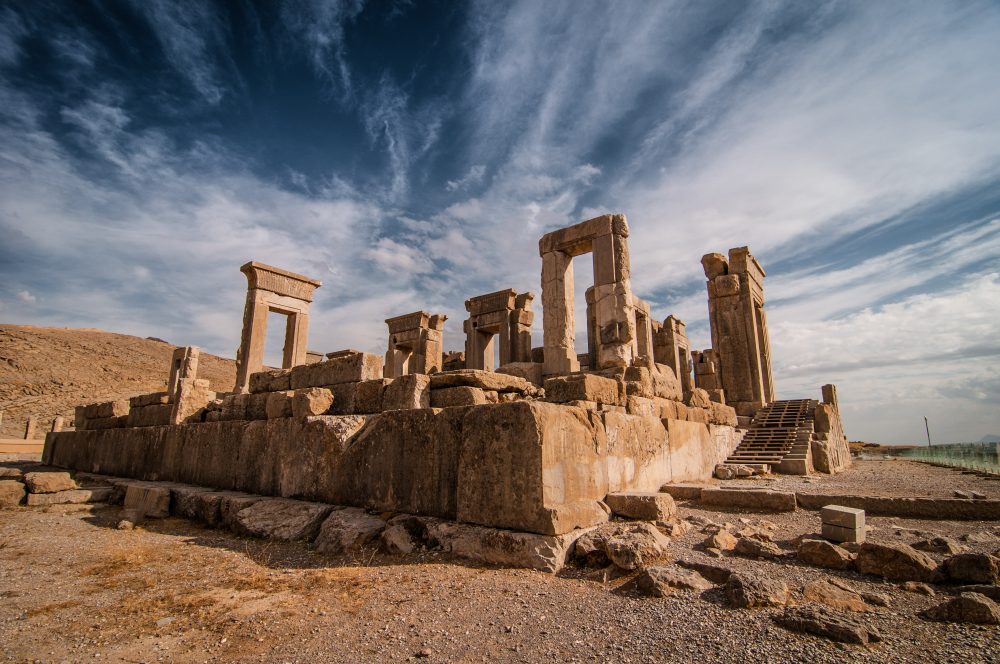
Persepolis Travel Guide: Discover the Heart of Ancient Persia
Shiraz is filled with remarkable attractions such as the Nasir al-Mulk Mosque and the beautiful tomb of Hafez, but its greatest highlight is without doubt Persepolis, a UNESCO World Heritage Site and one of Iran’s most iconic landmarks.
This ancient city, once the celebrated capital of the Persian Empire, showcases the depth of Iran’s history and culture. Known by names such as Parse, Forty Minars, and Hazar Seton, Persepolis served as a major center for royal ceremonies and grand celebrations, especially during Nowruz in the Achaemenid era.
Today, Persepolis remains the most impressive historic monument near Shiraz, offering travelers the chance to walk among majestic columns, detailed carvings, and the architectural brilliance that defined ancient Persia. Travelers from around the world visit this site each year to experience the grandeur of a civilization that shaped history.
“In Persia, the first light emerges, illuminating both itself and everything around it… The principle of development starts with the history of Persia; thus, it marks the beginning of history.”
— Hegel, 1857
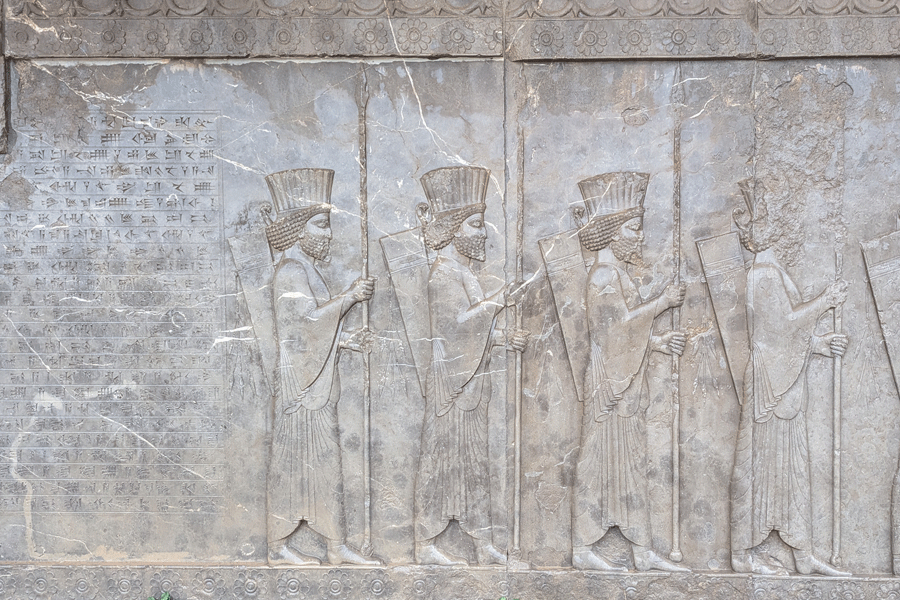
Location and Historical Significance of Persepolis in Iran
Persepolis served as the capital of the Persian Achaemenid Empire from the reign of Darius I (522-486 BCE) until its fall in 330 BCE. Darius I, aiming to revitalize the Persian administration, moved the capital from Pasargadae (established by Cyrus the Great) to Persepolis, starting construction between 518 and 515 BCE. However, due to its remote location in the highlands and the challenges of accessing it during the rainy Persian winters, other cities like Ecbatana, Babylon, and Susa also functioned as key administrative centers for the empire.
Persepolis was designed as the king’s residence for the summer and spring seasons and served as a grand venue for hosting formal ceremonies with leaders from subject states.
The Persepolis complex features five grand palaces or halls of various sizes, impressive entrances, and is situated on a high, walled platform. The exact purpose of Persepolis remains unclear. It was not a major city in Persia, nor did it serve as the empire’s primary residence. Instead, it appears to have been a lavish ceremonial center used occasionally. The location of the king’s private quarters is still unknown. Until recently, many archaeologists believed that Persepolis was primarily used to celebrate Nowruz, the Persian New Year, which is a significant annual festival in modern Iran and is celebrated during the spring equinox.
Definition of Persepolis
The Persians called it Parsa, but its name comes from the Greek term “Perses-polis,” meaning “City of the Persians.” In American English, Persepolis is pronounced “per-seh-POH-lis,” while in Persian, it is pronounced پِرسِپولیس.
The Destruction of Persepolis
In 330 BCE, Alexander the Great invaded Persepolis, the capital of Persia. After plundering the city’s treasures, he set fire to the grand palace and much of the surrounding area. Once the shining jewel of Persia, Persepolis was left in ruins by the time Alexander departed. For many years afterward, it was remembered only by the remnants of its last standing columns, often referred to as “the site of the forty columns.”
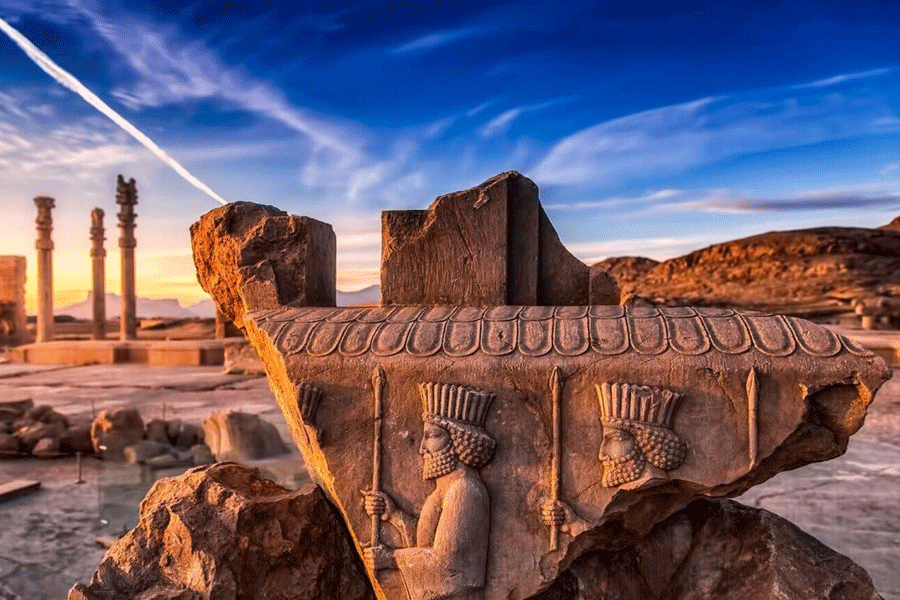
The very next morning and for the remainder of his life, Alexander began to regret the destruction caused by his invasion.
After spending a considerable amount of time in Iran, Alexander the Great developed a deep appreciation for its culture and people. Eventually, he abandoned his Macedonian robes in favor of Iranian attire. He embraced Iranian customs, preferred Iranian cuisine to Greek and Macedonian dishes, and even encouraged Greeks and Macedonians to marry Persians.
He was deeply disturbed upon discovering the looted tomb of Cyrus the Great in Pasargadae, a small town north of Persepolis. Promptly, he ordered repairs to be carried out.
The Geography of Persepolis
Persepolis is situated near where the Kor and Pulvar (Sivand) rivers meet. The site boasts a sprawling terrace covering 125,000 square meters (1,350,000 square feet), an impressive blend of human engineering and natural rock carving. The terrace is supported on the east by Rahmat Mountain, with retaining walls on the other three sides, varying in height according to the slope. On the west side, a double staircase ascends from 16 to 43 feet (5 to 13 meters) and leads gently to the terrace’s summit. To level the terrace, depressions were filled with dirt and large boulders, which were secured with metal clips.
Art and Architecture of Persepolis
One of the most remarkable elements of Persepolis is its distinctive Persian columns. These impressive structures are believed to have been inspired by earlier wooden designs. When the finest cedars from Lebanon and teak from India could not meet the size and strength required, the builders turned to stone, crafting strong bases and beautifully carved capitals.
In 518 BC, the Achaemenid kings gathered the world’s best architects, engineers, and artists to create the first monumental buildings of Persepolis. Their work resulted in a timeless masterpiece that still reflects the ideals of peace, unity, and cooperation that defined the Persian Empire.
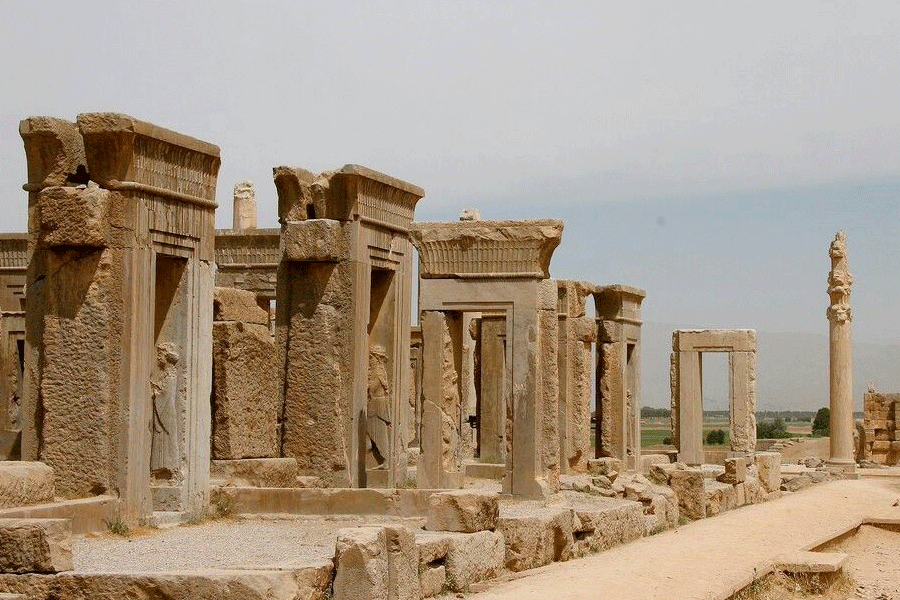
Architecture of the Persepolis Complex
The architecture of Persepolis can be broadly categorized into three main types: the Treasury, the royal reception areas, and the military quarters. Notable buildings within these categories include the Apadana, the Hall of a Hundred Columns, the Tripylon Hall, the Tachara, the Hadish Palace, the Palace of Artaxerxes III.
According to an inscription on the southern face of the Terrace, Darius the Great was the founder of Persepolis. Although construction began in 518 B.C., it took nearly 100 years for Artaxerxes I to complete the massive project. Significant preliminary work was required before any buildings could be constructed, including leveling and shaping a rough, rocky slope to create the extensive platform and filling gaps and depressions with debris.
Tablets inscribed in Old Persian and Elamite discovered at Persepolis reveal that Darius envisioned this magnificent palace complex not merely as a center of administration but chiefly as a grand display and a magnificent center for gatherings and festivals for the Achaemenian monarchs and their empire. Darius lived just long enough to see some of his vision come to life
In examining the Persepolis platform, it’s essential to note that the northern part, which housed the Throne Hall, the Gate of Xerxes, and the Audience Hall of the Apadana, comprised the official section of the complex and was reserved for a select group. The Harem, the Council Hall, and other facilities were located in the southern part of the city. The Terrace complex features the following buildings and notable characteristics:
The Apadana
The Apadana, begun by Darius and completed by Xerxes, stands as the largest and most impressive structure at Persepolis. It was primarily used for grand celebrations. Accessed by two massive staircases—one on the north and one on the east—the large platform still features thirteen of its original seventy-two columns. These columns are adorned with detailed reliefs that depict scenes from the New Year’s festival and processions of representatives from the 23 subject nations of the Achaemenid Empire. The reliefs include court officials, Persians, Medes, military personnel, their horses, and royal chariots.

Delegates present gifts as a token of their allegiance and tribute to the monarch while wearing their national attire, some of which are distinctly Persian in design. The gifts include vases and containers made of silver and gold, weapons, woven textiles, jewels, and animals from the delegates’ countries. Although the overall layout of the scenes may seem repetitive, there are distinct variations in the attire, headpieces, hairstyles, and beards, which provide each delegation with a unique identity and clearly indicate their origin.
The design also achieves diversity through the use of stylized trees, which create decorative bands or separate different groups and activities. Additionally, the intentional use of patterns and rhythmic repetition of figures and groups contributes to a grandiose ornamental effect.
The Throne Hall at Persepolis
The Throne Hall, often referred to as the “Hundred-Column Hall,” is the second-largest structure on the Persepolis Terrace, following the Apadana. Construction began under Xerxes and was completed by his son Artaxerxes I by the end of the fifth century B.C. The hall features eight stone entrances, each adorned with decorative scenes: throne scenes on the north and south and depictions of the king battling monsters on the east and west.
Flanking the building’s northern portico are two massive stone bulls. In its early days, Xerxes predominantly utilized the Throne Hall for grand receptions, welcoming delegates from across all the nations under the empire’s dominion. Later, as the Treasury became inadequate, the Throne Hall was repurposed as a storage facility. It also became an important venue for displaying items, including treasures and spoils, from the royal Treasury.
The Persepolis Treasury
The Treasury, situated adjacent to the Throne Hall, served both as an armory and as a royal storeroom for the Achaemenian rulers. The vast wealth stored here was amassed from the spoils of conquered territories and the annual tribute brought.
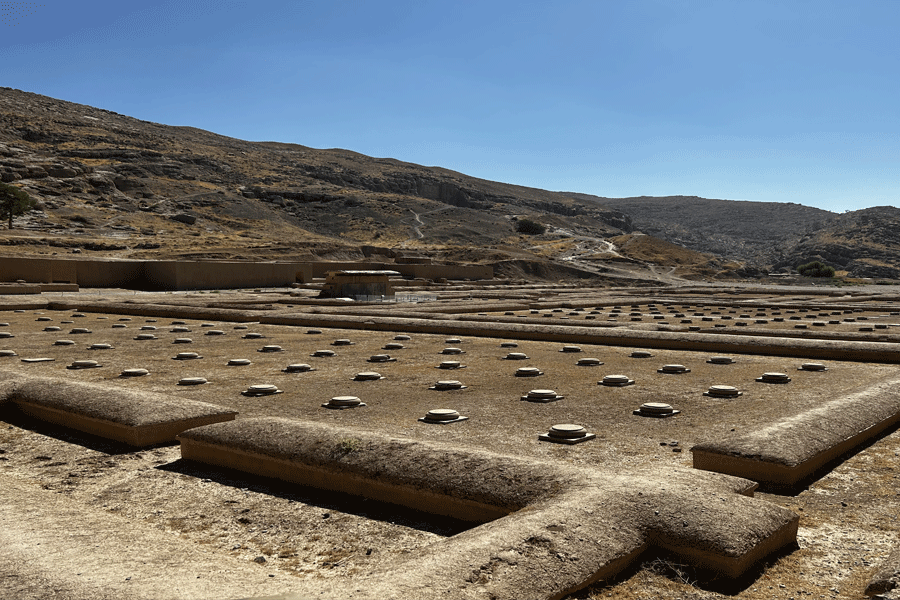
Before the Throne Hall was finished, the largest room in the Treasury served as the venue for Court of Reception ceremonies. This room contained two prominent stone reliefs that illustrate its function. The reliefs depict Darius I seated on his throne, with a high dignitary approaching and performing a respectful gesture with his hand to his lips. Crown Prince Xerxes is shown standing behind the king, accompanied by court officials.
The Tachara (Palace of Darius) at Persepolis
The Palace of Darius, also known as the Tachara, features a central hall supported by twelve columns. This hall is accessed by three small staircases, which are depicted in reliefs showing servants ascending with covered platters of food and animals for the king’s banquets. The northern and southern doorways are adorned with reliefs of the king in battle with monsters, while the eastern and western doorjambs portray the king departing the palace in formal attire, accompanied by two attendants.

The Hadish Palace (Palace of Xerxes) at Persepolis
Apart from the two large inscriptions of Xerxes on the eastern and western gateways, the stone doorframes and windows of Xerxes’ Palace are elaborately decorated, featuring ornamental elements nearly twice as intricate as those found in the Palace of Darius. The door reliefs depict servants with ibexes, in contrast to the battle scenes with monsters seen in Darius’ Palace. Unfortunately, the reliefs in Xerxes’ Palace are in much poorer condition compared to those in the Palace of Darius.
The Council Hall at Persepolis
Access to the royal rooms was via three doors located on a grand staircase. The first two doors were for general access, while the third door served as a discreet entrance to the Harem.
The Gate of Xerxes (Gate of the Nations)
The Gate of Xerxes, situated north of the Apadana, features a broad staircase leading down to the Terrace. This gate was the only entry point to the Terrace and served as the passage for all guests proceeding to the Throne Hall to pay tribute to the monarch. Xerxes, who commissioned the structure, named it “The Gate of the Nations.” The gate comprises a large central chamber with a roof supported by four stone columns with bell-shaped bases. Inside, a stone bench runs along the interior walls, interrupted only by the doors.
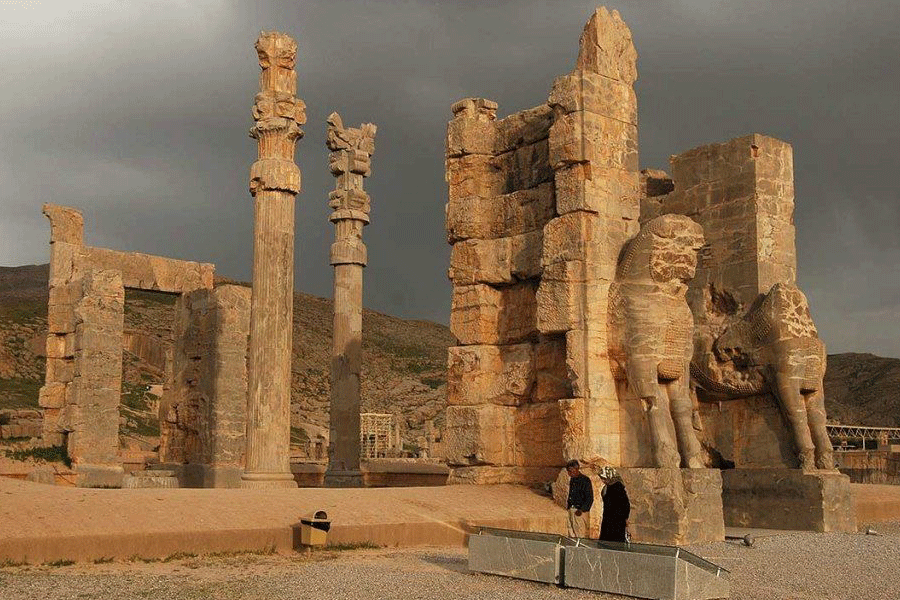
The building features solid mud-brick outer walls adorned with numerous niches. Each of the three main walls—east, west, and south—has a large stone gateway. The western gate is flanked by two massive bulls, while the eastern entrance is protected by two human-headed winged bulls, known as lamassu. Above each of the four colossi, a trilingual inscription details the construction and completion of the gate by Xerxes. The southernmost gateway, which faces the Apadana, is the largest of the three.
The gateways likely featured two-leaved doors, probably constructed from wood and covered with decorative metal sheets. This inference is based on the presence of pivoting mechanisms found on the inner corners of each entry
Xerxes’ Harem
The Harem, the residence of the royal women, was designed in an L-shaped layout. The west wing extends from the southern end of the central wing, which runs north-south.
The central wing features a large columned hall as its focal point, with a portico facing a spacious courtyard to the north. The lobby of the hall is adorned with four entrances, each framed by relief-decorated jambs. The southern doorway’s frame depicts Xerxes entering the hall, accompanied by two servants—one holding a fly whisk and the other a parasol over the king’s head. The eastern entryway is framed by a relief showing Xerxes vanquishing a lion-headed monster.
The western entryway features reliefs depicting the monarch engaged in battle with a lion. While the specific location of the queen’s chambers remains uncertain, it is likely that she and her entourage resided in this prominent central area. The main section of the primary wing contained six apartments arranged in two rows south of the columned hall. Each apartment comprised a large central room with pillars, along with one or two smaller rooms. Similarly, the west wing housed sixteen additional apartments with a comparable layout.
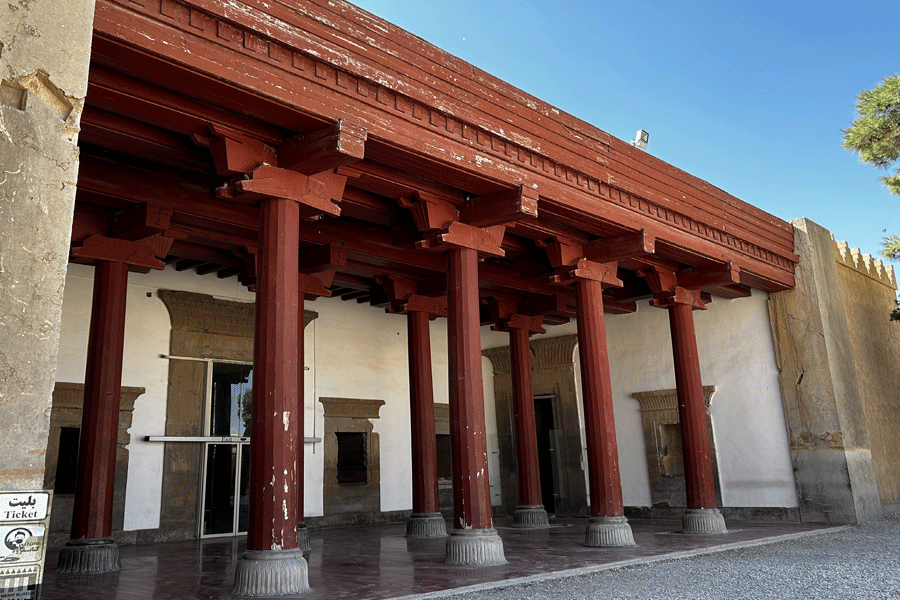
In addition to the entrance from the Council Hall leading to the northern part of the Harem’s main wing, two staircases connected the west wing to the Palace of Xerxes. There were also two entrances that provided access to walled gardens or courtyards. A third possible exit at the eastern end of the west wing may have led to an open space or an area with removed boundaries. The front section of the Harem has been restored and converted into a museum to display artifacts discovered at Persepolis.
The Imperial Tombs at Persepolis
Located approximately 4.8 kilometers northwest of Persepolis, in the Husain Kuh Rocky Mountains, is the impressive site of Naqsh-i-Rustam. Here, the monumental graves of Darius the Great and his successors have been carved into the rock.
Darius the Great selected Naqsh-i-Rustam as a burial site, although the location had been considered sacred long before his time, as evidenced by the ruins of a Pre-Achaemenid relief. Darius’s successors adopted his approach to cliffside burials and emulated the design of his tomb. The exterior of the tomb is notable for its striking cross-like appearance.
The tomb chamber features a deeply carved entrance in the rock. Above this doorway, a relief depicts the king standing before an altar on a three-stepped pedestal, performing a worshipful gesture with his raised hand. Above him hovers the winged disk of Ahuramazda, the Zoroastrian deity. The relief also includes throne bearers representing the twenty-eight countries of the empire, while the side panels illustrate Persian guards and weapon-bearers attending to the monarch.
Early historians consistently described the wealth of Persepolis as unparalleled. The city was renowned for its immense riches, with homes filled with gold, silver, and various other treasures.

Historians anticipated that the Oriental Institute’s expeditions would uncover numerous artifacts. However, in 331/30 B.C., Alexander the Great and his army extensively looted and burned Persepolis. Consequently, the artifacts discovered by the Oriental Institute were those that the Macedonians either overlooked or accidentally left behind.
Most of the artifacts discovered came from the royal storeroom in the Treasury, with fewer items found in the Terrace’s other structures. Many of these artifacts were either looted during conflicts with other nations, such as Greece, Egypt, and India, or were tribute items from the empire’s vassal states. Some artifacts clearly exhibit cultural influences from these regions. Tablets discovered at the site reveal that Darius I invited numerous foreign artists and artisans
to his court. While the Persians drew on their talent and inspiration, they did not simply imitate foreign styles.
A significant number of clay tablets inscribed with Elamite cuneiform were found among the ruins of the Treasury. The intense fire that ravaged the structure had the effect of baking these initially sun-dried tablets, preserving many of them in remarkably intact condition rather than allowing them to disintegrate into dust.
These tablets, which include inscriptions in Old Persian along with translations in Elamite and Babylonian, are invaluable to archaeologists. They provide evidence that skilled artisans from various regions of the empire were present in Persepolis. Among these were Egyptian craftsmen who worked on stone reliefs and inscriptions, Carian goldsmiths, and artisans from Susa known for their ornamental work.
Some of the tablets offer detailed information on the month and year of Darius’ or Xerxes’ reign, the completion dates of specific tasks, and the payments made to employees, either in goods or cash. Other tablets document purchases, land transactions, taxes owed, and amounts borrowed from the Treasury. Additionally, some tablets provide instructions on the quantity of haoma, a sacred alcoholic beverage, to be used during religious rituals.
The inscriptions found on seals, wall pegs, and foundation slabs were crucial for archaeologists in dating the Persepolis artifacts. These items often bore the name of the local Achaemenid king. Cylinder seals, typically made of stone, frequently depict various scenes such as hunting, combat, ceremonies, offerings, or animal battles. The royal seals of Darius and Xerxes consistently illustrate the king in triumphant battles against dangerous beasts or monsters, a theme also represented in the royal reliefs.
Additional Discoveries at Persepolis
The ruins of Persepolis yielded a variety of artifacts that offer insights into the daily life and military practices of the Achaemenid Empire. Among the finds were fragments of vessels inscribed with details of their use at the royal table, revealing aspects of the ceremonial dining practices of the kings. Additionally, numerous tools, weights, mortars, and pastels were uncovered, indicating the diverse range of activities and crafts practiced within the city.
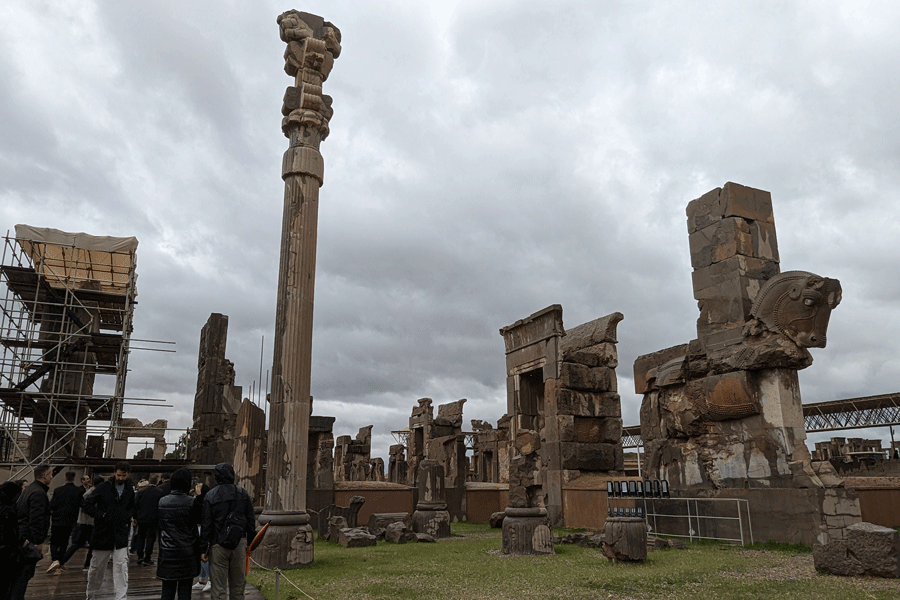
The Treasury and the garrison quarters also contained extensive collections of combat gear. These included numerous arrowheads, scabbard fittings, and bridle ornaments, which reflect the military and equestrian culture of the period. These artifacts collectively contribute to a deeper understanding of the administrative, ceremonial, and martial aspects of Persepolis.
After the destruction and looting of Persepolis by Alexander’s forces, only a limited number of artifacts remained. These included a few pieces of jewelry, some gold and silver coins, and a small number of silver buttons. Notably, no precious metal vessels were recovered from the site. However, several alabaster bowls and bottles were found, some of which bore inscriptions and dates confirming their origins as gifts sent from Egypt to Persepolis during the reigns of Darius and Xerxes.
Additionally, some vessels were made of “Egyptian blue,” a synthetic pigment composed of copper, calcium, and tetrasilicate. This distinctive bluish-green material, highly valued in antiquity, was a prized import from Egypt, where the technique for producing this pigment was developed during the Fourth Dynasty.
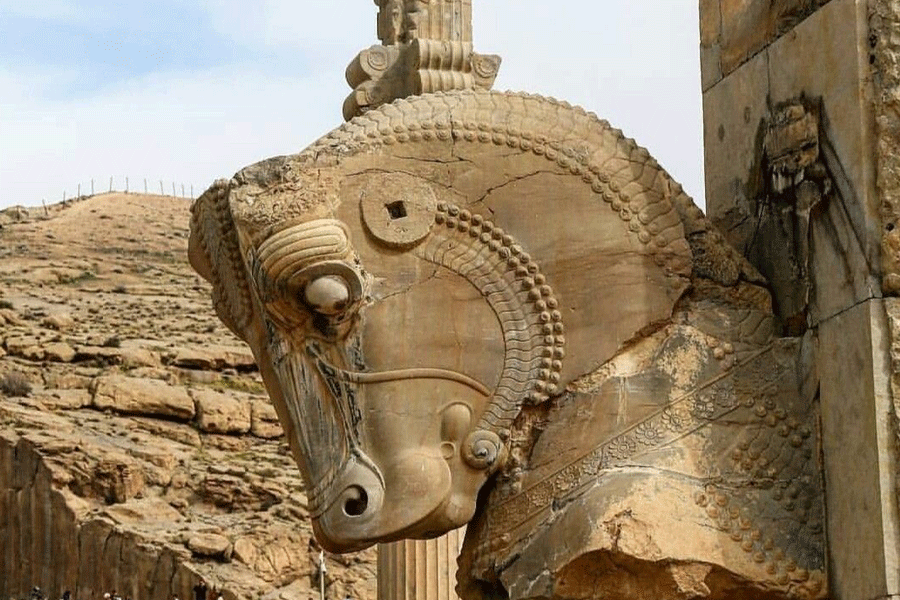
Ruins and Remains of Persepolis
The Terrace at Persepolis features the remains of several large structures, all constructed from dark gray marble. Currently, 15 columns from these edifices are still standing, and since 1970, three additional columns have been reconstructed. Many of these structures were left incomplete.
Among the more than 30,000 inscriptions unearthed from the Persepolis excavation, the most valuable records from the Achaemenid era have been found. These inscriptions are generally brief and concise in both size and content. Most of these inscriptions, currently housed in the United States, provide evidence that wage payments were made to workers during the Persepolis period.
Conclusion
Persepolis stands as a key historical site in Shiraz, representing the splendor of pre-Islamic Iran. The remains and ruins of Persepolis offer valuable insights into early human civilization, making it a crucial destination for scholars and archaeologists from around the world.
The city of Persepolis fell into obscurity, buried under the rubble of its own destruction. Although it remained the official capital of the defeated empire for a time, local inhabitants referred to it simply as “the site of the forty columns,” due to the few remaining columns that still stood amid the ruins.
Excavations at Persepolis have been ongoing since 1931, with interruptions only due to regional conflicts. Situated in the Fars region of Iran, northwest of Shiraz, Persepolis has become a significant historical site. Designated a UNESCO World Heritage Site in 1979, it attracts global visitors eager to experience the remnants of this once-grand metropolis.

